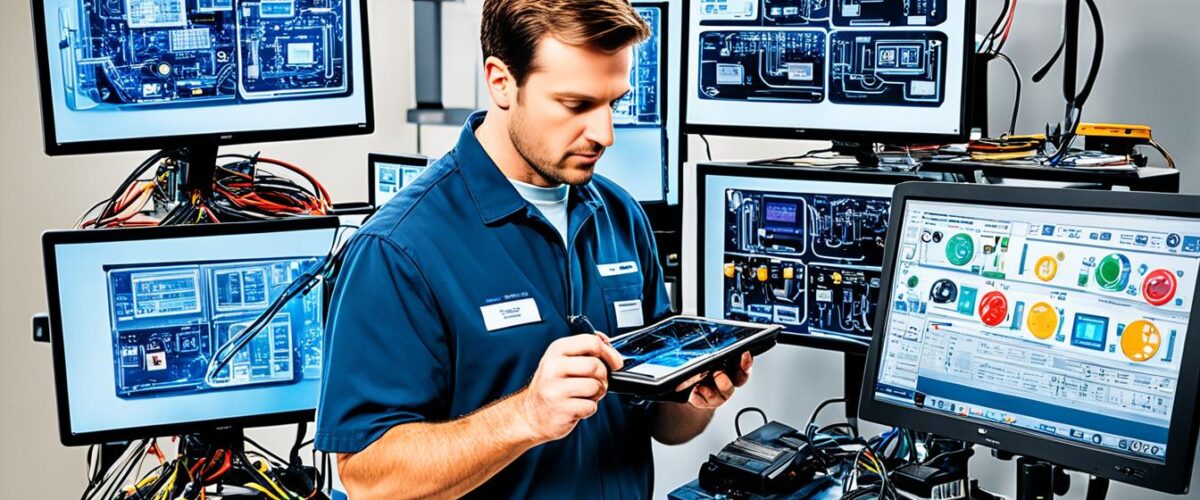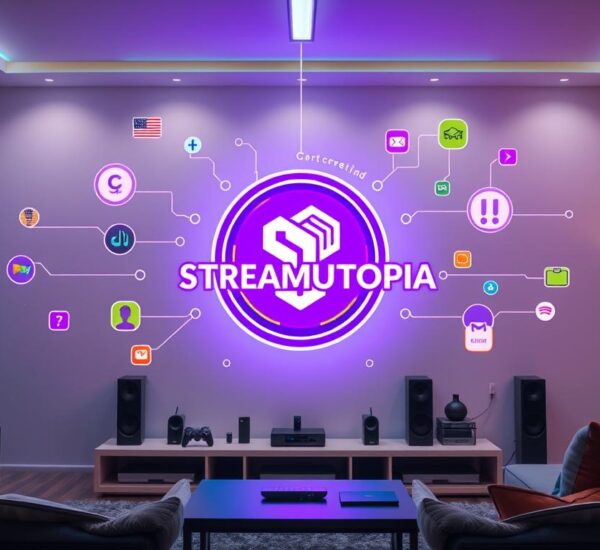Do you know that the technology meant to make watching shows better could also cause problems? Learning how to fix common IPTV issues can help you avoid frustration with buffering or freezing during your favorite shows.
This guide aims to tackle the usual IPTV problems. It offers solutions to keep your streaming smooth. Issues like signal loss, slow internet, and device compatibility can ruin your viewing. Plus, buffering delays and poor video quality are big problems, often due to slow internet or bad router placement12>. This guide will show you how to fix IPTV issues and enjoy your shows without interruptions.
Key Takeaways
- Buffering and freezing are major IPTV issues for many users.
- Having the right bandwidth for SD and HD streaming is key for a great experience.
- Doing speed tests can help spot network problems.
- Restarting devices can fix slow connections.
- Keeping devices updated ensures IPTV works well.
- Choosing the right devices is important for quality streaming.
- Preventing issues can reduce interruptions during watching.
Understanding IPTV and Its Common Challenges
IPTV delivers TV content over the internet, unlike traditional cable or satellite services. It offers many benefits but also has challenges. Users often face buffering delays due to slow internet or network congestion during busy times2.
Device performance is key to a good IPTV experience. Older devices may not handle the data well2. Server issues, like overloads or technical problems, can also cause interruptions2. Misconfigured routers or firewalls can block smooth data transport2.
To overcome these issues, it’s important to understand IPTV’s technical side. Factors like bandwidth, latency, and packet loss affect video quality3. Using adaptive bitrate streaming can help reduce buffering and keep the stream stable3. Choosing the right video codecs and formats also improves delivery3.
Quality of Service (QoS) mechanisms are crucial for a great video streaming experience3. Regular testing and troubleshooting help users fix technical problems quickly. This improves the IPTV experience for users.
Learn more about advanced IPTV solutions.
How IPTV Works and Why Issues Occur
IPTV uses the internet to send TV signals. This lets users watch shows on devices like TVs, computers, smartphones, and tablets4. It’s a new way to watch live TV, movies, and videos without traditional cable or satellite4. But, it can have problems like unstable internet and old software on devices5.
For the best experience, you need a fast internet connection. At least 10 Mbps is needed for HD streaming6. Wired connections are better than wireless because they cut down on buffering and freezing5. If your internet speed is slow, it can cause problems with IPTV, so you might need to fix it quickly5.
There are many IPTV services starting at just €2.9 a month5. This makes it affordable for many people. You can pick what you want to watch without the old TV schedule4. IPTV stores shows on servers, so you can watch what you like whenever you want4.

Identifying Common IPTV Problems
Many users face issues with IPTV that can ruin their viewing. Problems like buffers and freezes often come from slow internet speeds. HD videos need 5 to 9 Mbps for smooth streaming7. It’s important to spot these IPTV problems to fix them and enjoy streaming.
Server overload and device compatibility also play a part in these issues. Internet problems are common and can mess with IPTV. To fix this, check for loose cables, broken hardware, and restart your modem and router8.
Interference and congestion can also block smooth streaming. If you’re seeing buffers, try using a 5.0 GHz network to improve your Wi-Fi signal7. Also, turn off devices you’re not using to reduce network traffic.
Stop downloads and updates while streaming to avoid video stutter from bandwidth use. Regularly checking for these IPTV problems is key to a good viewing experience. Knowing what causes these issues helps users spot and fix them early.
How to Troubleshoot Common IPTV Issues
Ensuring a smooth IPTV experience means troubleshooting common issues. Start by checking your internet connection. A stable connection is key for uninterrupted streaming. You’ll need at least 5Mbps for standard video quality, and 4K UHD streaming requires 30/40Mbps9
Check for Internet Connectivity
First, make sure your internet is working well. If IPTV issues pop up, test your internet speed. For the best experience, your speed should hit the minimums: 5Mbps for HD and 25Mbps for 4K10. Resetting your router can fix many connection problems; just unplug it for 30 seconds before plugging it back in10.
Inspect Your Streaming Device
Your streaming device is also key to solving IPTV problems. Make sure it’s updated with the latest software. Updates often fix bugs and improve performance10. Double-check all cables and connections to avoid any disruptions. If problems don’t go away, try clearing the app cache or reinstalling the IPTV app10.
Review Your IPTV Subscription Status
Finally, check your IPTV subscription status. This makes sure your account is active and paid up. If payment issues or an expired subscription block access, your viewing will be affected. Contact your IPTV service provider’s customer support if you face login or account problems10.
Fixing IPTV Buffering and Freezing Problems
Buffering and freezing are common issues for IPTV users. Finding out why these problems happen is key to solving them. By figuring out what causes buffering, users can make their streaming smoother and without interruptions.
Diagnosing Buffering Issues
To fix IPTV buffering, first check your internet speed. You need at least 5 Mbps for standard quality, but 10 Mbps is better for 720p HD11. For 1080 HD, you’ll need 20 Mbps, and 30 Mbps for 4K11.
Things that can slow your connection include how close you are to the router, how many devices are connected, and the Wi-Fi signal strength12. Using a wired connection usually helps a lot, giving you better performance than Wi-Fi. Wi-Fi should be at least 25 Mbps for direct connections12.
Adjusting Stream Quality Settings
Adjust your stream quality based on your internet speed to cut down on buffering. If slow speeds cause problems, try lowering the stream quality for better performance13. Clearing your cache and cookies regularly also helps keep the app running smoothly13.
If you’re still having trouble, think about using a VPN. A VPN can reduce buffering and keep your streaming private13.
Resolving IPTV Signal Loss Issues
IPTV signal loss can really mess up your viewing. It’s important to know how to spot interference and boost your connection for smooth streaming. Look for things like other devices or objects that might block your signal. Checking your space for these issues can help solve problems.
Identifying Sources of Signal Interference
Things like nearby wireless devices can mess with your signal. If your router is in a bad spot, your signal will suffer. Look for things like microwaves, cordless phones, or Bluetooth devices near your setup to see if they’re causing trouble. Doing an IPTV signal loss troubleshoot can help find and fix these problems. Try to keep your streaming device and router away from other electronics.
Using Wired Connections for Stability
Wired connections are usually more stable than wireless ones. Switching to an Ethernet cable can often fix signal issues. This cuts down on the wireless signal problems. Keeping your network gear updated also helps with streaming reliability. Updating your equipment and placing your router right can give you steady IPTV access. These steps are key to fixing IPTV signal loss and keeping your streaming smooth11411.
Updating IPTV Application and Software
It’s key to keep the IPTV app and device software updated for the best performance. Regular checks for IPTV app updates help avoid problems like compatibility issues. These updates often bring important improvements, security fixes, and new features, making watching TV better.
Restarting IPTV devices can often fix many errors, including TV guide issues15. To get the most from updating IPTV software, follow these steps:
- Look for the latest versions of IPTV apps in the app store.
- Make sure your streaming device’s firmware is up-to-date.
- Keep an eye out for updates from your service providers.
Old or damaged IPTV software can cause many problems, like poor video quality or apps crashing. If these issues happen, you might need to contact your IPTV service provider16. By keeping your IPTV updated and fixing software problems, you can improve your viewing experience and reduce interruptions.
Troubleshooting IPTV Error Codes
IPTV users often run into error codes that point to specific problems. Knowing about IPTV error codes helps fix these issues. Issues can stem from slow internet, ISP throttling, geo-restrictions, or outdated apps17. To solve these problems, try restarting your device, checking your subscription, or looking at your network settings17.

Understanding Common Error Codes
There are many error codes that can affect your IPTV service. For example:
| Error Code | Description |
|---|---|
| 404 | Channel Not Found – This is usually due to server problems or the channel being unavailable18. |
| 503 | Service Unavailable – This means the service is down for maintenance or is too busy18. |
| 102 | Buffering Issues – This is often caused by a slow internet connection18. |
| 403 | Access Denied – You might not have the right subscription or be in the right region18. |
| 504 | Gateway Timeout – This happens when the server doesn’t answer quickly18. |
| 502 | Bad Gateway – This is when you get an invalid response while processing18. |
Steps to Fix Error Messages
To fix IPTV error messages, follow these steps:
- Make sure your internet is stable19.
- Update the IPTV app to the newest version19.
- Change settings like resolution or connection type for better performance19.
- Use a VPN to get around ISP throttling and avoid buffering19.
- Clear the IPTV app’s cache to fix any glitches17.
- Turn off devices you don’t need to use less bandwidth19.
- If these steps don’t work, contact customer support for help19.
Contacting IPTV Customer Support
If you can’t fix the problem yourself, it’s time to talk to IPTV customer support. Being ready for your call can make things go smoother and faster. Make sure you have all your info ready.
How to Prepare for a Support Call
Getting ready is important for talking to IPTV customer support. Begin by gathering all important details. This includes:
- Your account info, like your username and subscription details.
- A clear description of the problems you’re facing, including any error messages.
- Any steps you’ve tried to fix the issue already.
Gathering Necessary Information
Having the right info makes your support call go better. Think about these points too:
- Write down any TV guide errors or problems you’ve seen, like issues with watching shows or movies15.
- Check your internet speed and stability, as these can cause guide errors20.
- If you’re streaming on multiple devices, check how many are connected to avoid problems20.
If you can’t fix the issue yourself, you’ll need to contact your IPTV service or vendor for help15.
Additional Tips to Prevent IPTV Issues
To make your IPTV better, you need to take some steps to avoid problems. Having a stable internet is key for smooth streaming. By following some tips, you can make your IPTV more reliable and work better.
Maintaining a Stable Internet Environment
Having a stable internet is crucial. For IPTV to stream well, you need at least 7-10 Mbps for downloading and 1-3 Mbps for uploading12. If you’re using Wi-Fi, aim for speeds of at least 150 Mbps based on your home setup12. Getting a high-speed internet plan, like those from FibreStream, starting at 100 Mbps, will greatly enhance your IPTV7.
Try not to do other network-using activities at the same time, like downloading torrents, while watching IPTV. These can cause buffering. Using a wired Ethernet connection is better than Wi-Fi because it’s more stable and has less interference7.
Using Quality Streaming Devices
Buying good streaming devices can make your IPTV better. It’s best to use IPTV boxes made for IPTV, not Android boxes with emulators12. These devices are made for IPTV and don’t need extra setup, which helps cut down on buffering. Connecting your IPTV box directly to your internet with an Ethernet Power Line Adapter can also reduce freezing and buffering12.
Make sure to update your device’s firmware regularly to keep it working right and avoid technical problems7.

Understanding IPTV Connection Issues
IPTV connection problems can really slow down your streaming. A big 75% of users face Wi-Fi issues like trouble connecting or buffering21. About 50% struggle with Ethernet, leading to slow speeds or no internet21. Weak or unstable internet is a top reason for buffering, especially when many people are online at the same time22.
Audio issues also bother 40% of users, with some getting no sound or hearing distorted audio21. 30% of IPTV users deal with apps crashing or not working right21. Using troubleshooting tips can help fix many problems. For example, 25% of issues come from slow or unresponsive devices21.
Knowing the basic network needs is key. You’ll need at least 5Mbps for standard definition and 25Mbps for high definition streaming1. Keeping your devices and software updated is also crucial, as old firmware can cause connection problems22. Putting your router in a good spot can also improve your IPTV streaming.
Common IPTV Problems Related to App Performance
App performance issues can really impact how well you enjoy IPTV. A big problem is when the IPTV app gets slow because of too much cache and data. To fix this, it’s easy to clear app cache and data. If that doesn’t work, you might need to reinstall the IPTV app.
Clearing App Cache and Data
When your IPTV app is slow, try clearing app cache. This gets rid of temporary files that might be causing trouble. Studies show that simple steps like running a speed test or clearing the cache can fix many issues1.
Reinstalling the IPTV Application
If clearing the cache doesn’t help, you might need to reinstall the IPTV app. This gets rid of any bad files that could be causing problems. Reinstalling can make streaming smoother, especially if there were errors the first time around7. Just make sure you have good internet, as slow speeds can still cause problems11.

Alternative Devices for Testing IPTV Service
If you’re having trouble with IPTV, trying different devices can help find the problem. Testing on various platforms helps figure out if the issue is with your device or the service. This method helps fix hardware problems and ensures a smooth streaming experience.
Devices like Amazon FireStick and NVIDIA Shield work well with IPTV. They support video up to 1080p HD, which is best for watching videos clearly (you’ll need at least 25Mbps internet for smooth streaming)23. Also, services like Xtreme HD IPTV offer over 21,000 channels, giving users lots of choices24.
When trying out different devices, think about how many devices can connect to the IPTV service at once. Some services let you connect many devices, making it easier for everyone. Also, choosing legal IPTV from trusted app stores means you’re more likely to have a reliable service.
Reviewing Subscription Packages and Limitations
When looking at IPTV subscription packages, it’s key to know the options and limits. Users should check what each package offers, like channels and bandwidth limits. Services like StreamUtopia.com have various prices and channels for different needs.
Some popular IPTV services have monthly plans starting at $10.99, like Fubo IPTV. Others, such as Liveplayer IPTV, have prices from $19/month to $128 for two years. Providers like Smart IPTV and TobigoTv also have different prices, like €14.99 for one month or €34.99 for three months25.
The use of IPTV is growing, especially in the United States, Canada, and the UK. Countries like India and Brazil are also catching up fast. This shows a big demand for IPTV services25. IPTV is known for its great image and sound quality, thanks to its careful use of bandwidth for video26.
When checking out IPTV subscription packages, it’s important to look at the channels and prices. Users should think about the trend of OTT services adding more content to IPTV26. Knowing these things helps users pick the best IPTV subscription for their viewing habits.
Conclusion
This guide has shown how to fix IPTV problems for a better streaming experience. Platforms like Firestick make IPTV popular because it’s affordable and easy to use. IPTVGANG offers over 10,000 live TV channels for different tastes27.
Issues like buffering, which bothers about 45% of users, can be fixed by using Ethernet instead of Wi-Fi28. Regular updates and clearing the cache help too. Using IPTVUNLOCK also gives an ad-free experience and strong security27.
Using routers with Adaptive QoS technology can cut buffering by up to 50% and make streaming better28. It’s important to talk to customer support if problems don’t go away. Being proactive and using the right tools helps IPTV users watch their favorite shows without trouble29.
FAQ
What causes IPTV buffering issues?
How can I fix IPTV freezing problems?
What should I do if I experience signal loss with my IPTV service?
How do I troubleshoot common IPTV error codes?
Why are app performance issues a concern for IPTV users?
When should I contact IPTV customer support?
What are some preventative strategies to avoid IPTV issues?
How can I test my IPTV service on alternative devices?
What should I know about IPTV subscription packages?





